NSG3NCR Literature Review: Hypoglycemia in Diabetes Management
VerifiedAdded on 2023/06/03
|27
|5101
|110
Literature Review
AI Summary
This literature review provides a comprehensive analysis of hypoglycemia in type 1 and type 2 diabetes patients, exploring the impact of various physical, social, and psychological factors. The review includes a detailed search strategy, documented using a PRISMA flow diagram, and analyzes fifteen relevant studies based on their methodologies, findings, and limitations. Key themes identified include the role of social determinants of health, the effectiveness of semaglutide in managing blood glucose levels, and the impact of drug-drug interactions on hypoglycemia risk. The review highlights the importance of continuous glucose monitoring and early detection of risk factors for effective hypoglycemia management, offering valuable insights for healthcare professionals and students. Desklib offers a variety of resources, including past papers and solved assignments, to further support student learning.

Running head: EVIDENCE BASED TEMPLATE FILL UP
Evidence based template fill up
Name of the student:
Name of the university:
Author note:
Evidence based template fill up
Name of the student:
Name of the university:
Author note:
Paraphrase This Document
Need a fresh take? Get an instant paraphrase of this document with our AI Paraphraser
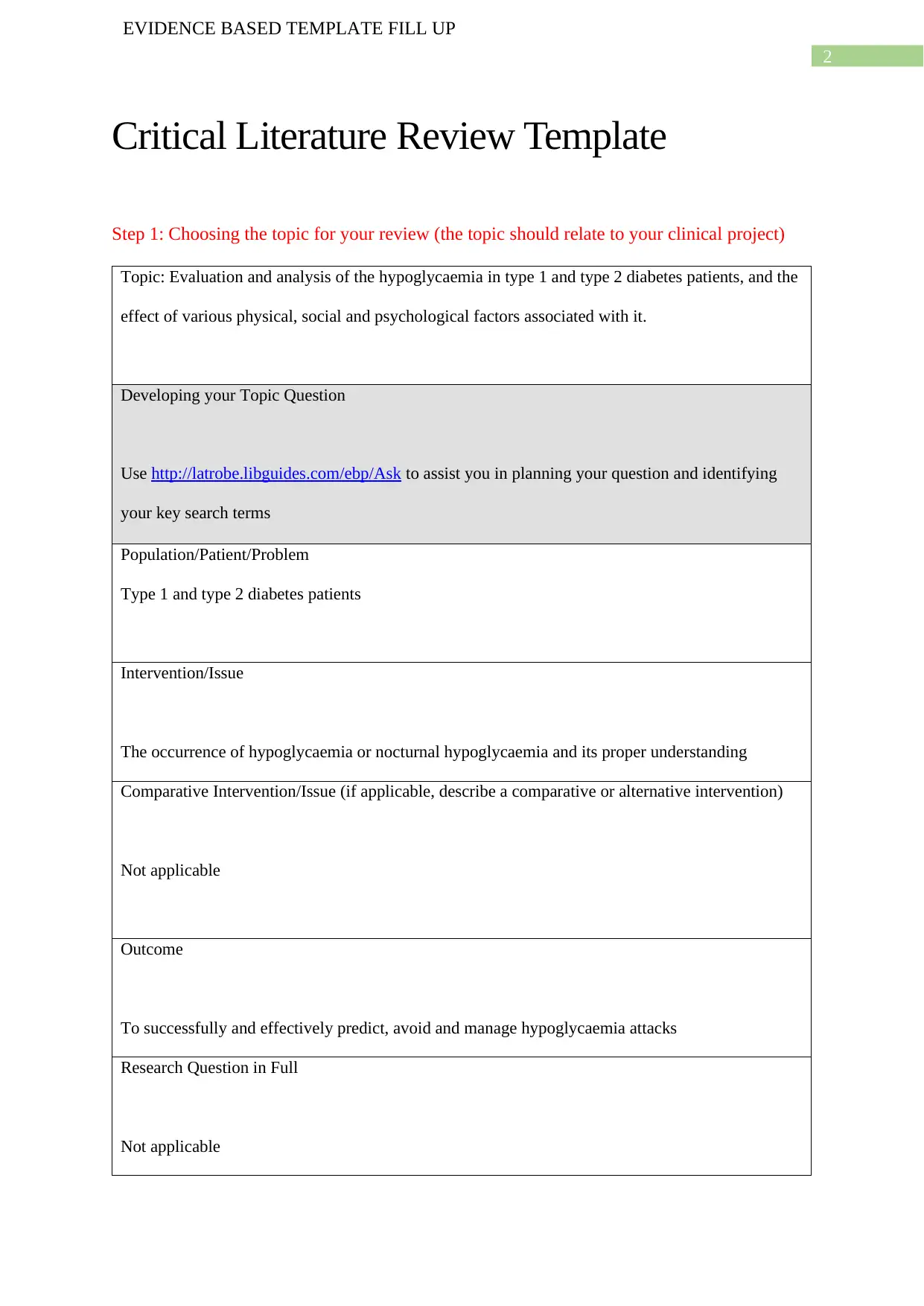
2
EVIDENCE BASED TEMPLATE FILL UP
Critical Literature Review Template
Step 1: Choosing the topic for your review (the topic should relate to your clinical project)
Topic: Evaluation and analysis of the hypoglycaemia in type 1 and type 2 diabetes patients, and the
effect of various physical, social and psychological factors associated with it.
Developing your Topic Question
Use http://latrobe.libguides.com/ebp/Ask to assist you in planning your question and identifying
your key search terms
Population/Patient/Problem
Type 1 and type 2 diabetes patients
Intervention/Issue
The occurrence of hypoglycaemia or nocturnal hypoglycaemia and its proper understanding
Comparative Intervention/Issue (if applicable, describe a comparative or alternative intervention)
Not applicable
Outcome
To successfully and effectively predict, avoid and manage hypoglycaemia attacks
Research Question in Full
Not applicable
EVIDENCE BASED TEMPLATE FILL UP
Critical Literature Review Template
Step 1: Choosing the topic for your review (the topic should relate to your clinical project)
Topic: Evaluation and analysis of the hypoglycaemia in type 1 and type 2 diabetes patients, and the
effect of various physical, social and psychological factors associated with it.
Developing your Topic Question
Use http://latrobe.libguides.com/ebp/Ask to assist you in planning your question and identifying
your key search terms
Population/Patient/Problem
Type 1 and type 2 diabetes patients
Intervention/Issue
The occurrence of hypoglycaemia or nocturnal hypoglycaemia and its proper understanding
Comparative Intervention/Issue (if applicable, describe a comparative or alternative intervention)
Not applicable
Outcome
To successfully and effectively predict, avoid and manage hypoglycaemia attacks
Research Question in Full
Not applicable

3
EVIDENCE BASED TEMPLATE FILL UP
EVIDENCE BASED TEMPLATE FILL UP
⊘ This is a preview!⊘
Do you want full access?
Subscribe today to unlock all pages.

Trusted by 1+ million students worldwide
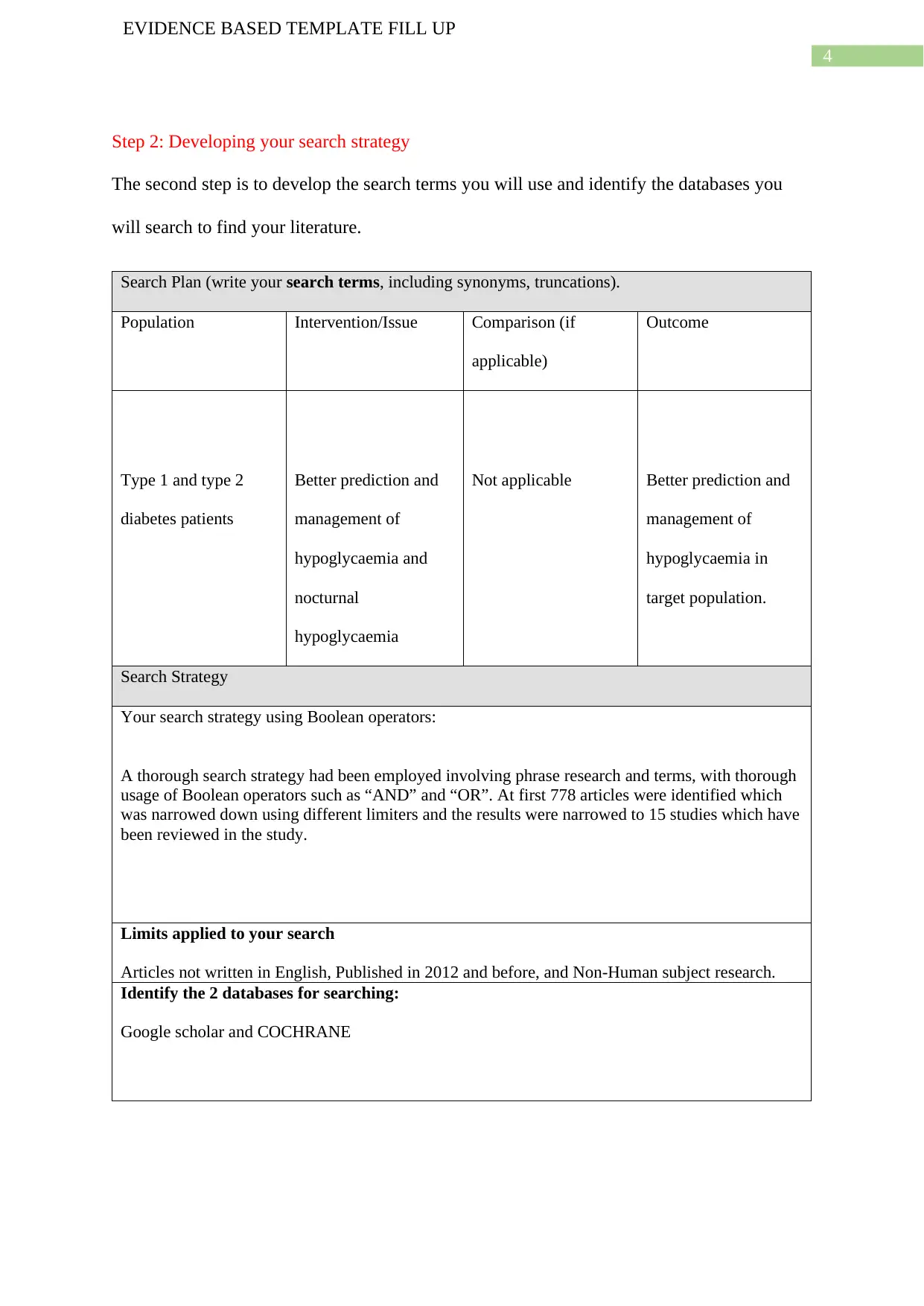
4
EVIDENCE BASED TEMPLATE FILL UP
Step 2: Developing your search strategy
The second step is to develop the search terms you will use and identify the databases you
will search to find your literature.
Search Plan (write your search terms, including synonyms, truncations).
Population Intervention/Issue Comparison (if
applicable)
Outcome
Type 1 and type 2
diabetes patients
Better prediction and
management of
hypoglycaemia and
nocturnal
hypoglycaemia
Not applicable Better prediction and
management of
hypoglycaemia in
target population.
Search Strategy
Your search strategy using Boolean operators:
A thorough search strategy had been employed involving phrase research and terms, with thorough
usage of Boolean operators such as “AND” and “OR”. At first 778 articles were identified which
was narrowed down using different limiters and the results were narrowed to 15 studies which have
been reviewed in the study.
Limits applied to your search
Articles not written in English, Published in 2012 and before, and Non-Human subject research.
Identify the 2 databases for searching:
Google scholar and COCHRANE
EVIDENCE BASED TEMPLATE FILL UP
Step 2: Developing your search strategy
The second step is to develop the search terms you will use and identify the databases you
will search to find your literature.
Search Plan (write your search terms, including synonyms, truncations).
Population Intervention/Issue Comparison (if
applicable)
Outcome
Type 1 and type 2
diabetes patients
Better prediction and
management of
hypoglycaemia and
nocturnal
hypoglycaemia
Not applicable Better prediction and
management of
hypoglycaemia in
target population.
Search Strategy
Your search strategy using Boolean operators:
A thorough search strategy had been employed involving phrase research and terms, with thorough
usage of Boolean operators such as “AND” and “OR”. At first 778 articles were identified which
was narrowed down using different limiters and the results were narrowed to 15 studies which have
been reviewed in the study.
Limits applied to your search
Articles not written in English, Published in 2012 and before, and Non-Human subject research.
Identify the 2 databases for searching:
Google scholar and COCHRANE
Paraphrase This Document
Need a fresh take? Get an instant paraphrase of this document with our AI Paraphraser
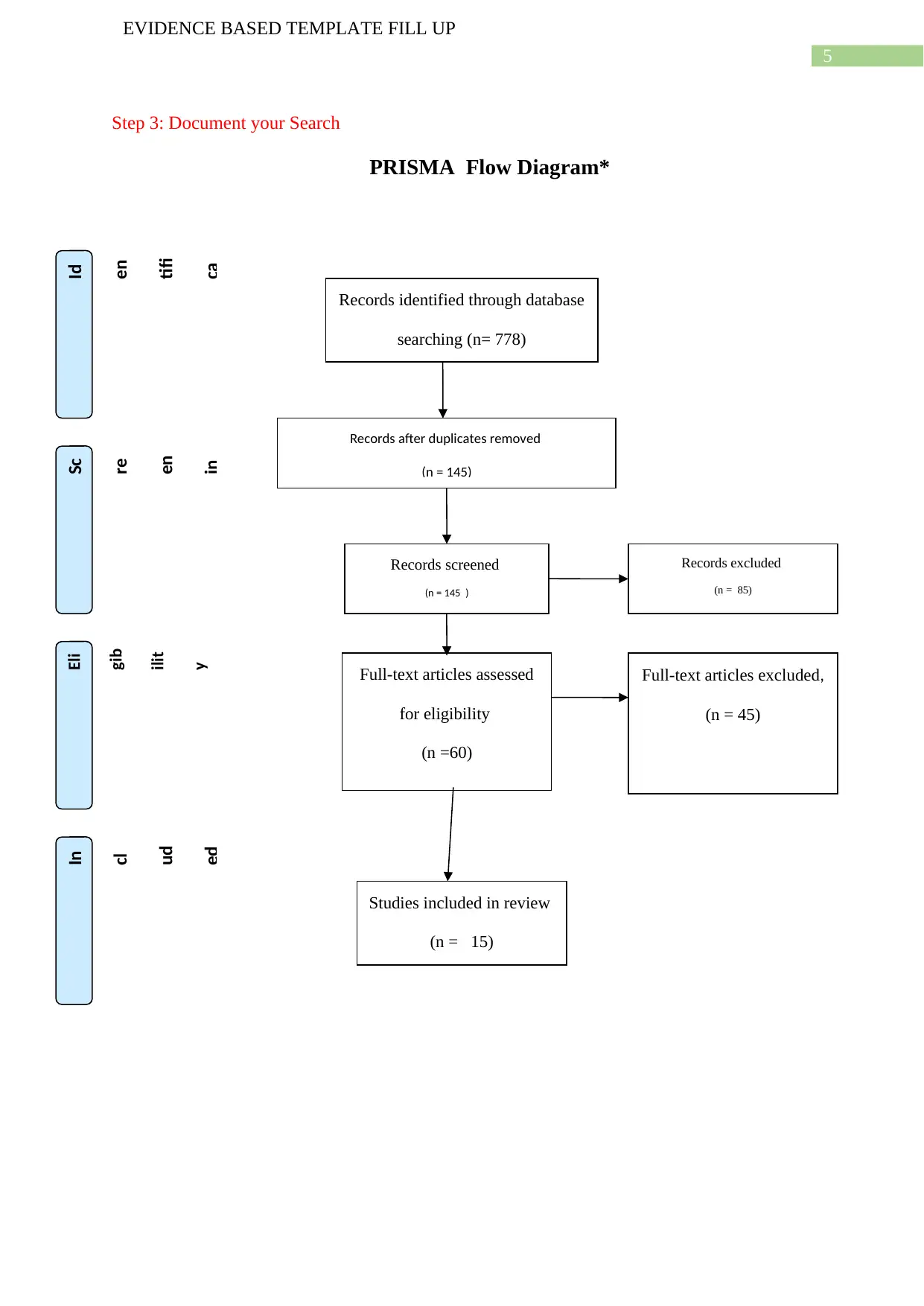
5
EVIDENCE BASED TEMPLATE FILL UP
Step 3: Document your Search
PRISMA Flow Diagram*
Records identified through database
searching (n= 778)
(n = )
Sc
re
en
in
In
cl
ud
ed
Eli
gib
ilit
y
Id
en
tifi
ca
Records after duplicates removed
(n = 145)
Records screened
(n = 145 )
Records excluded
(n = 85)
Full-text articles assessed
for eligibility
(n =60)
Full-text articles excluded,
(n = 45)
Studies included in review
(n = 15)
EVIDENCE BASED TEMPLATE FILL UP
Step 3: Document your Search
PRISMA Flow Diagram*
Records identified through database
searching (n= 778)
(n = )
Sc
re
en
in
In
cl
ud
ed
Eli
gib
ilit
y
Id
en
tifi
ca
Records after duplicates removed
(n = 145)
Records screened
(n = 145 )
Records excluded
(n = 85)
Full-text articles assessed
for eligibility
(n =60)
Full-text articles excluded,
(n = 45)
Studies included in review
(n = 15)
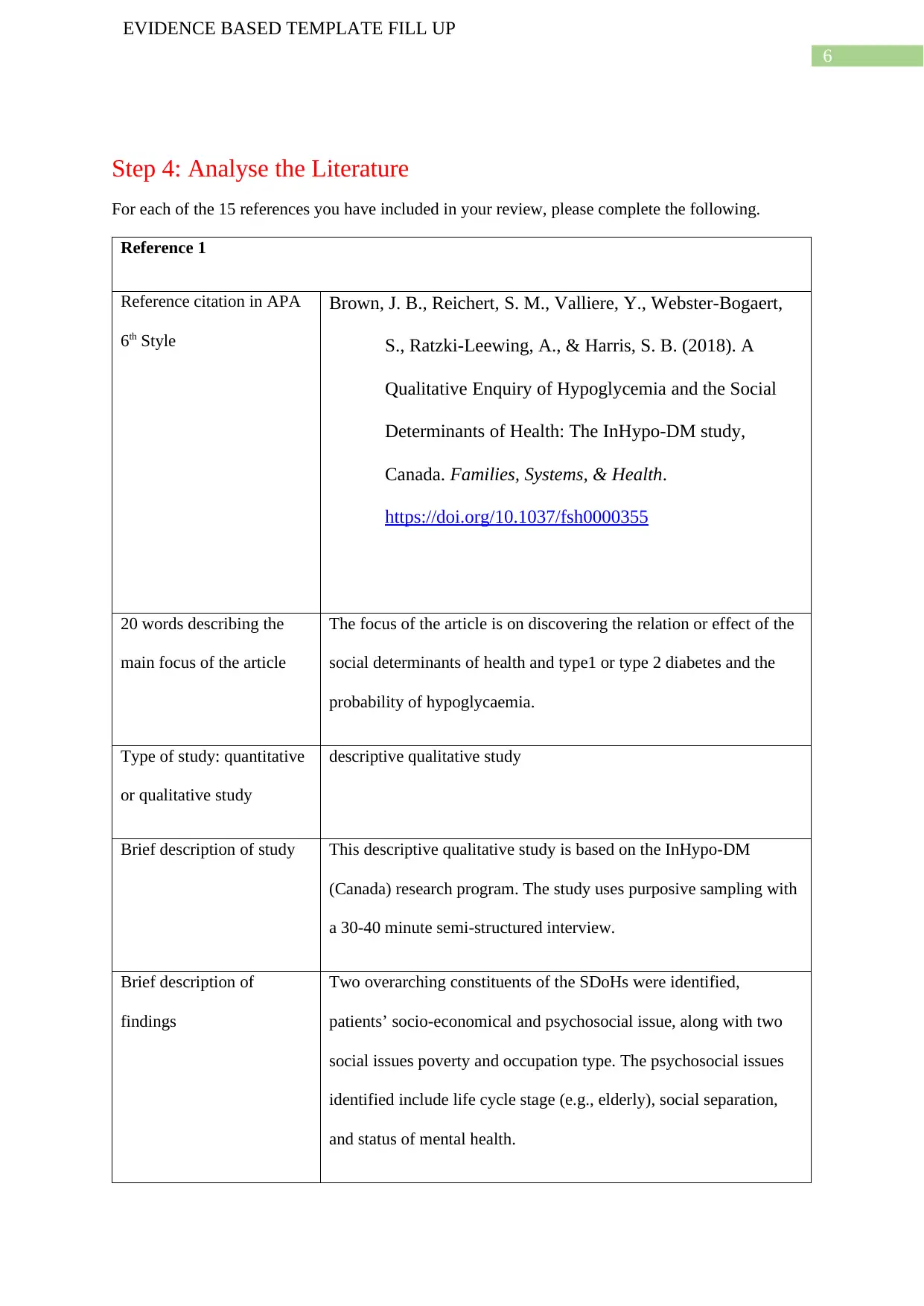
6
EVIDENCE BASED TEMPLATE FILL UP
Step 4: Analyse the Literature
For each of the 15 references you have included in your review, please complete the following.
Reference 1
Reference citation in APA
6th Style
Brown, J. B., Reichert, S. M., Valliere, Y., Webster-Bogaert,
S., Ratzki-Leewing, A., & Harris, S. B. (2018). A
Qualitative Enquiry of Hypoglycemia and the Social
Determinants of Health: The InHypo-DM study,
Canada. Families, Systems, & Health.
https://doi.org/10.1037/fsh0000355
20 words describing the
main focus of the article
The focus of the article is on discovering the relation or effect of the
social determinants of health and type1 or type 2 diabetes and the
probability of hypoglycaemia.
Type of study: quantitative
or qualitative study
descriptive qualitative study
Brief description of study This descriptive qualitative study is based on the InHypo-DM
(Canada) research program. The study uses purposive sampling with
a 30-40 minute semi-structured interview.
Brief description of
findings
Two overarching constituents of the SDoHs were identified,
patients’ socio-economical and psychosocial issue, along with two
social issues poverty and occupation type. The psychosocial issues
identified include life cycle stage (e.g., elderly), social separation,
and status of mental health.
EVIDENCE BASED TEMPLATE FILL UP
Step 4: Analyse the Literature
For each of the 15 references you have included in your review, please complete the following.
Reference 1
Reference citation in APA
6th Style
Brown, J. B., Reichert, S. M., Valliere, Y., Webster-Bogaert,
S., Ratzki-Leewing, A., & Harris, S. B. (2018). A
Qualitative Enquiry of Hypoglycemia and the Social
Determinants of Health: The InHypo-DM study,
Canada. Families, Systems, & Health.
https://doi.org/10.1037/fsh0000355
20 words describing the
main focus of the article
The focus of the article is on discovering the relation or effect of the
social determinants of health and type1 or type 2 diabetes and the
probability of hypoglycaemia.
Type of study: quantitative
or qualitative study
descriptive qualitative study
Brief description of study This descriptive qualitative study is based on the InHypo-DM
(Canada) research program. The study uses purposive sampling with
a 30-40 minute semi-structured interview.
Brief description of
findings
Two overarching constituents of the SDoHs were identified,
patients’ socio-economical and psychosocial issue, along with two
social issues poverty and occupation type. The psychosocial issues
identified include life cycle stage (e.g., elderly), social separation,
and status of mental health.
⊘ This is a preview!⊘
Do you want full access?
Subscribe today to unlock all pages.

Trusted by 1+ million students worldwide

7
EVIDENCE BASED TEMPLATE FILL UP
Brief description of study
limitations
The authors do not outline the limitations of the study although small
sample size and recall bias can be considered as notable limitations.
Reference 2
Reference citation in APA
6th Style
Coca, A., Valencia, A. L., Bustamante, J., Mendiluce, A., &
Floege, J. (2017). Hypoglycemia Following
Intravenous Insulin Plus Glucose For Hyperkalemia in
Patients with Impaired Renal Function. PLoS ONE,
12(2), 1–12.
https://doi.org/10.1371/journal.pone.0172961
20 words describing the
main focus of the article
To determine the incidence of hypoglycemia and severe
hypoglycaemia in a cohort of AKI and non-dialysis dependent CKD
patients that are on intravenous infusion of insulin plus glucose for
treating hyperkalemia.
Type of study: quantitative
or qualitative study
Retrospective cohort study (quantitative)
Brief description of study The authors reviewed charts of all the patients with AKI and the
CKD patients that are non-dialysis dependent that received 10 U of
insulin plus 50 g glucose to manage hyperkalemia from time period
ranging from December 1, 2013 to May 31, 2015 at the Department
of the authors.
Brief description of
findings
Among the one hundred sixty four episodes of hyperkalemia, Eleven
treatments (6.1%) was found to result in hypoglycemia and two
EVIDENCE BASED TEMPLATE FILL UP
Brief description of study
limitations
The authors do not outline the limitations of the study although small
sample size and recall bias can be considered as notable limitations.
Reference 2
Reference citation in APA
6th Style
Coca, A., Valencia, A. L., Bustamante, J., Mendiluce, A., &
Floege, J. (2017). Hypoglycemia Following
Intravenous Insulin Plus Glucose For Hyperkalemia in
Patients with Impaired Renal Function. PLoS ONE,
12(2), 1–12.
https://doi.org/10.1371/journal.pone.0172961
20 words describing the
main focus of the article
To determine the incidence of hypoglycemia and severe
hypoglycaemia in a cohort of AKI and non-dialysis dependent CKD
patients that are on intravenous infusion of insulin plus glucose for
treating hyperkalemia.
Type of study: quantitative
or qualitative study
Retrospective cohort study (quantitative)
Brief description of study The authors reviewed charts of all the patients with AKI and the
CKD patients that are non-dialysis dependent that received 10 U of
insulin plus 50 g glucose to manage hyperkalemia from time period
ranging from December 1, 2013 to May 31, 2015 at the Department
of the authors.
Brief description of
findings
Among the one hundred sixty four episodes of hyperkalemia, Eleven
treatments (6.1%) was found to result in hypoglycemia and two
Paraphrase This Document
Need a fresh take? Get an instant paraphrase of this document with our AI Paraphraser
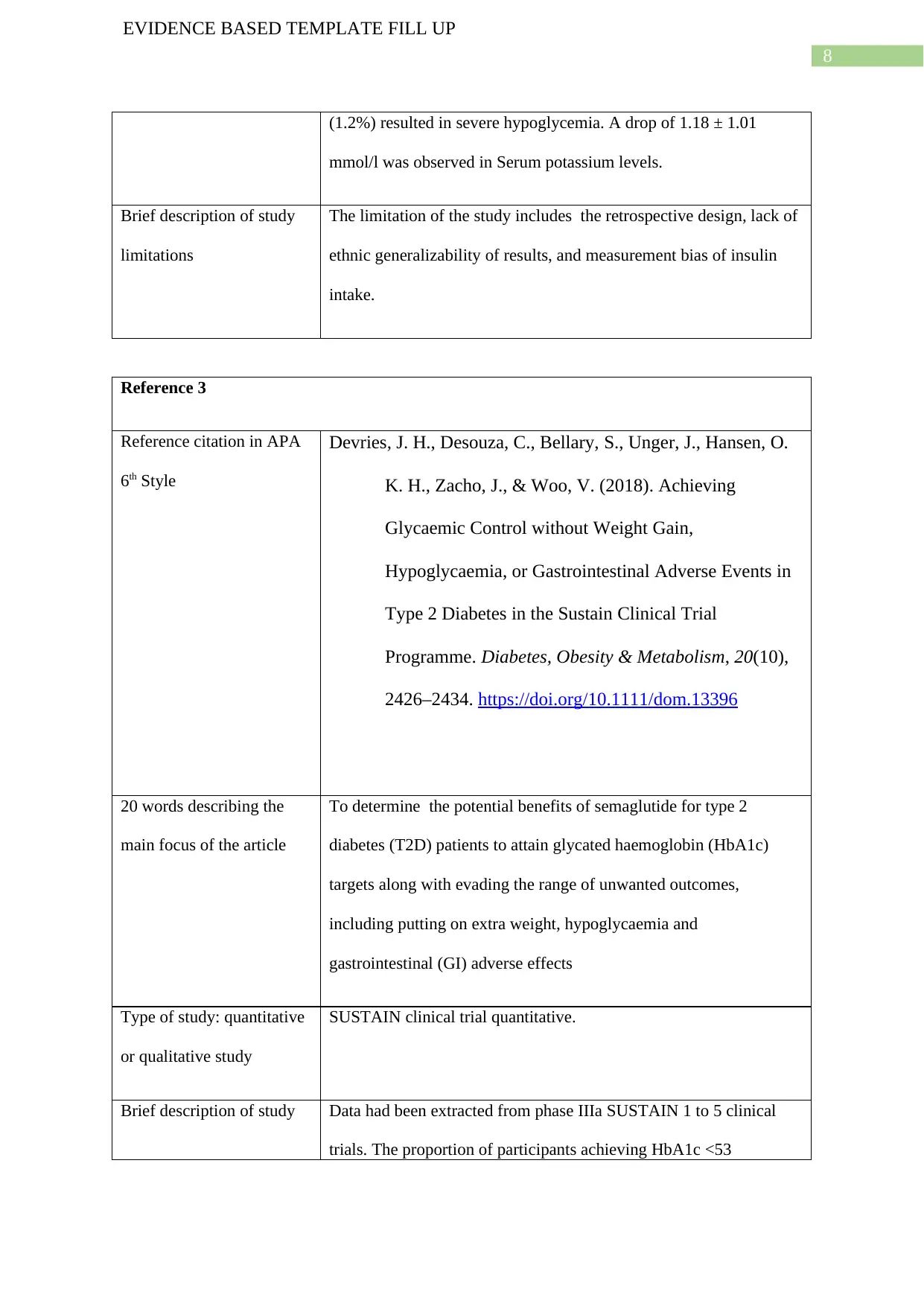
8
EVIDENCE BASED TEMPLATE FILL UP
(1.2%) resulted in severe hypoglycemia. A drop of 1.18 ± 1.01
mmol/l was observed in Serum potassium levels.
Brief description of study
limitations
The limitation of the study includes the retrospective design, lack of
ethnic generalizability of results, and measurement bias of insulin
intake.
Reference 3
Reference citation in APA
6th Style
Devries, J. H., Desouza, C., Bellary, S., Unger, J., Hansen, O.
K. H., Zacho, J., & Woo, V. (2018). Achieving
Glycaemic Control without Weight Gain,
Hypoglycaemia, or Gastrointestinal Adverse Events in
Type 2 Diabetes in the Sustain Clinical Trial
Programme. Diabetes, Obesity & Metabolism, 20(10),
2426–2434. https://doi.org/10.1111/dom.13396
20 words describing the
main focus of the article
To determine the potential benefits of semaglutide for type 2
diabetes (T2D) patients to attain glycated haemoglobin (HbA1c)
targets along with evading the range of unwanted outcomes,
including putting on extra weight, hypoglycaemia and
gastrointestinal (GI) adverse effects
Type of study: quantitative
or qualitative study
SUSTAIN clinical trial quantitative.
Brief description of study Data had been extracted from phase IIIa SUSTAIN 1 to 5 clinical
trials. The proportion of participants achieving HbA1c <53
EVIDENCE BASED TEMPLATE FILL UP
(1.2%) resulted in severe hypoglycemia. A drop of 1.18 ± 1.01
mmol/l was observed in Serum potassium levels.
Brief description of study
limitations
The limitation of the study includes the retrospective design, lack of
ethnic generalizability of results, and measurement bias of insulin
intake.
Reference 3
Reference citation in APA
6th Style
Devries, J. H., Desouza, C., Bellary, S., Unger, J., Hansen, O.
K. H., Zacho, J., & Woo, V. (2018). Achieving
Glycaemic Control without Weight Gain,
Hypoglycaemia, or Gastrointestinal Adverse Events in
Type 2 Diabetes in the Sustain Clinical Trial
Programme. Diabetes, Obesity & Metabolism, 20(10),
2426–2434. https://doi.org/10.1111/dom.13396
20 words describing the
main focus of the article
To determine the potential benefits of semaglutide for type 2
diabetes (T2D) patients to attain glycated haemoglobin (HbA1c)
targets along with evading the range of unwanted outcomes,
including putting on extra weight, hypoglycaemia and
gastrointestinal (GI) adverse effects
Type of study: quantitative
or qualitative study
SUSTAIN clinical trial quantitative.
Brief description of study Data had been extracted from phase IIIa SUSTAIN 1 to 5 clinical
trials. The proportion of participants achieving HbA1c <53
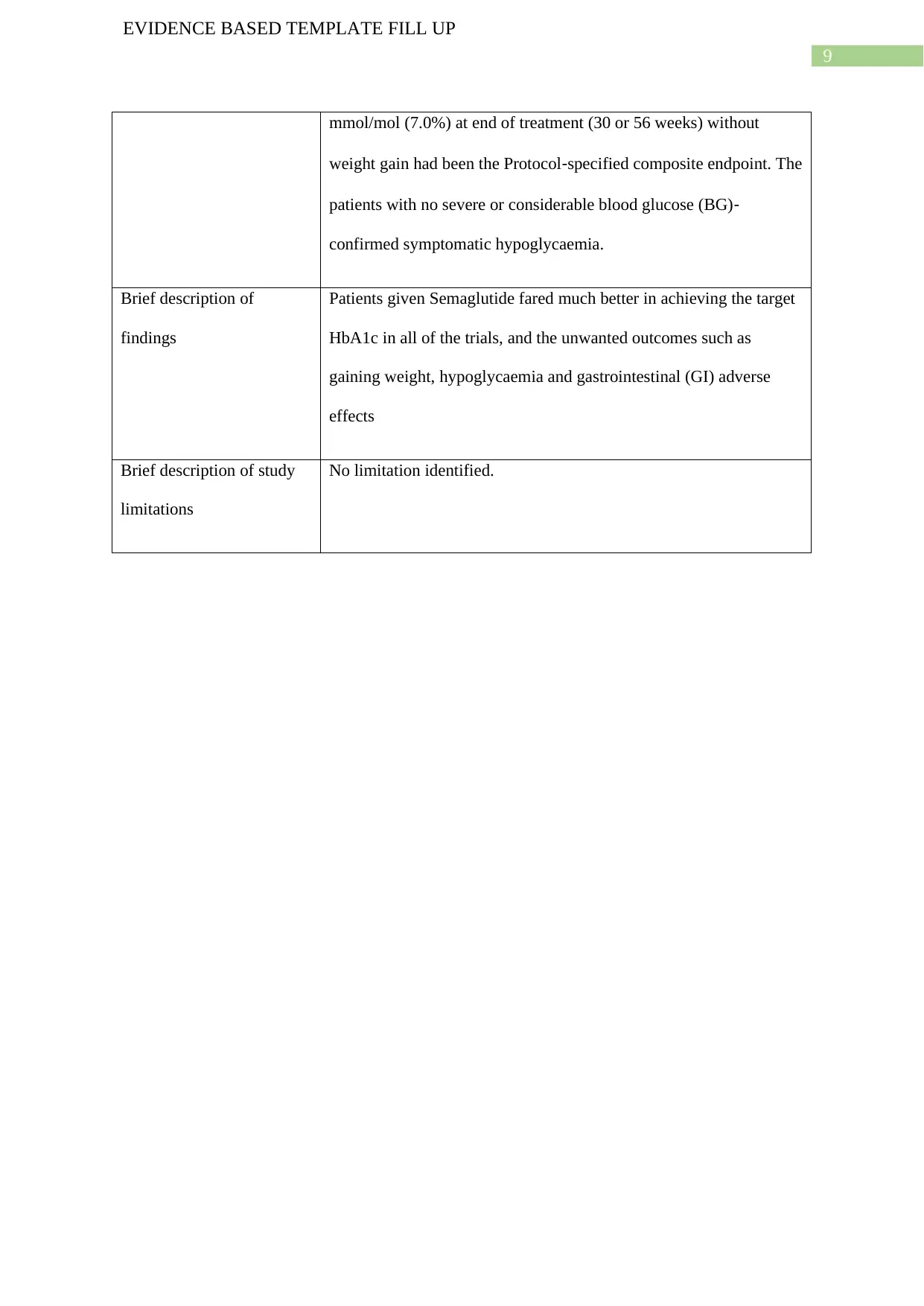
9
EVIDENCE BASED TEMPLATE FILL UP
mmol/mol (7.0%) at end of treatment (30 or 56 weeks) without
weight gain had been the Protocol‐specified composite endpoint. The
patients with no severe or considerable blood glucose (BG)‐
confirmed symptomatic hypoglycaemia.
Brief description of
findings
Patients given Semaglutide fared much better in achieving the target
HbA1c in all of the trials, and the unwanted outcomes such as
gaining weight, hypoglycaemia and gastrointestinal (GI) adverse
effects
Brief description of study
limitations
No limitation identified.
EVIDENCE BASED TEMPLATE FILL UP
mmol/mol (7.0%) at end of treatment (30 or 56 weeks) without
weight gain had been the Protocol‐specified composite endpoint. The
patients with no severe or considerable blood glucose (BG)‐
confirmed symptomatic hypoglycaemia.
Brief description of
findings
Patients given Semaglutide fared much better in achieving the target
HbA1c in all of the trials, and the unwanted outcomes such as
gaining weight, hypoglycaemia and gastrointestinal (GI) adverse
effects
Brief description of study
limitations
No limitation identified.
⊘ This is a preview!⊘
Do you want full access?
Subscribe today to unlock all pages.

Trusted by 1+ million students worldwide
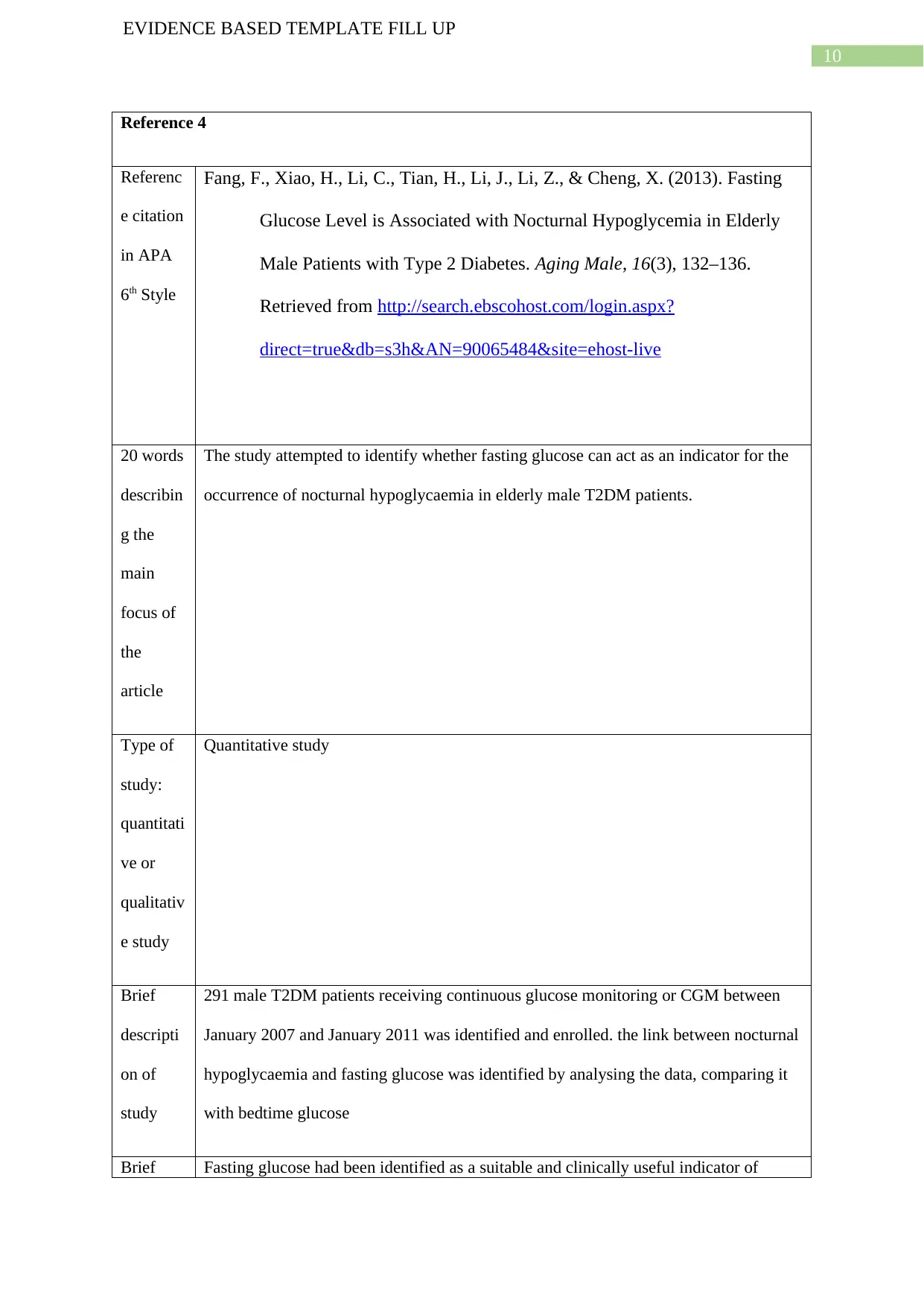
10
EVIDENCE BASED TEMPLATE FILL UP
Reference 4
Referenc
e citation
in APA
6th Style
Fang, F., Xiao, H., Li, C., Tian, H., Li, J., Li, Z., & Cheng, X. (2013). Fasting
Glucose Level is Associated with Nocturnal Hypoglycemia in Elderly
Male Patients with Type 2 Diabetes. Aging Male, 16(3), 132–136.
Retrieved from http://search.ebscohost.com/login.aspx?
direct=true&db=s3h&AN=90065484&site=ehost-live
20 words
describin
g the
main
focus of
the
article
The study attempted to identify whether fasting glucose can act as an indicator for the
occurrence of nocturnal hypoglycaemia in elderly male T2DM patients.
Type of
study:
quantitati
ve or
qualitativ
e study
Quantitative study
Brief
descripti
on of
study
291 male T2DM patients receiving continuous glucose monitoring or CGM between
January 2007 and January 2011 was identified and enrolled. the link between nocturnal
hypoglycaemia and fasting glucose was identified by analysing the data, comparing it
with bedtime glucose
Brief Fasting glucose had been identified as a suitable and clinically useful indicator of
EVIDENCE BASED TEMPLATE FILL UP
Reference 4
Referenc
e citation
in APA
6th Style
Fang, F., Xiao, H., Li, C., Tian, H., Li, J., Li, Z., & Cheng, X. (2013). Fasting
Glucose Level is Associated with Nocturnal Hypoglycemia in Elderly
Male Patients with Type 2 Diabetes. Aging Male, 16(3), 132–136.
Retrieved from http://search.ebscohost.com/login.aspx?
direct=true&db=s3h&AN=90065484&site=ehost-live
20 words
describin
g the
main
focus of
the
article
The study attempted to identify whether fasting glucose can act as an indicator for the
occurrence of nocturnal hypoglycaemia in elderly male T2DM patients.
Type of
study:
quantitati
ve or
qualitativ
e study
Quantitative study
Brief
descripti
on of
study
291 male T2DM patients receiving continuous glucose monitoring or CGM between
January 2007 and January 2011 was identified and enrolled. the link between nocturnal
hypoglycaemia and fasting glucose was identified by analysing the data, comparing it
with bedtime glucose
Brief Fasting glucose had been identified as a suitable and clinically useful indicator of
Paraphrase This Document
Need a fresh take? Get an instant paraphrase of this document with our AI Paraphraser
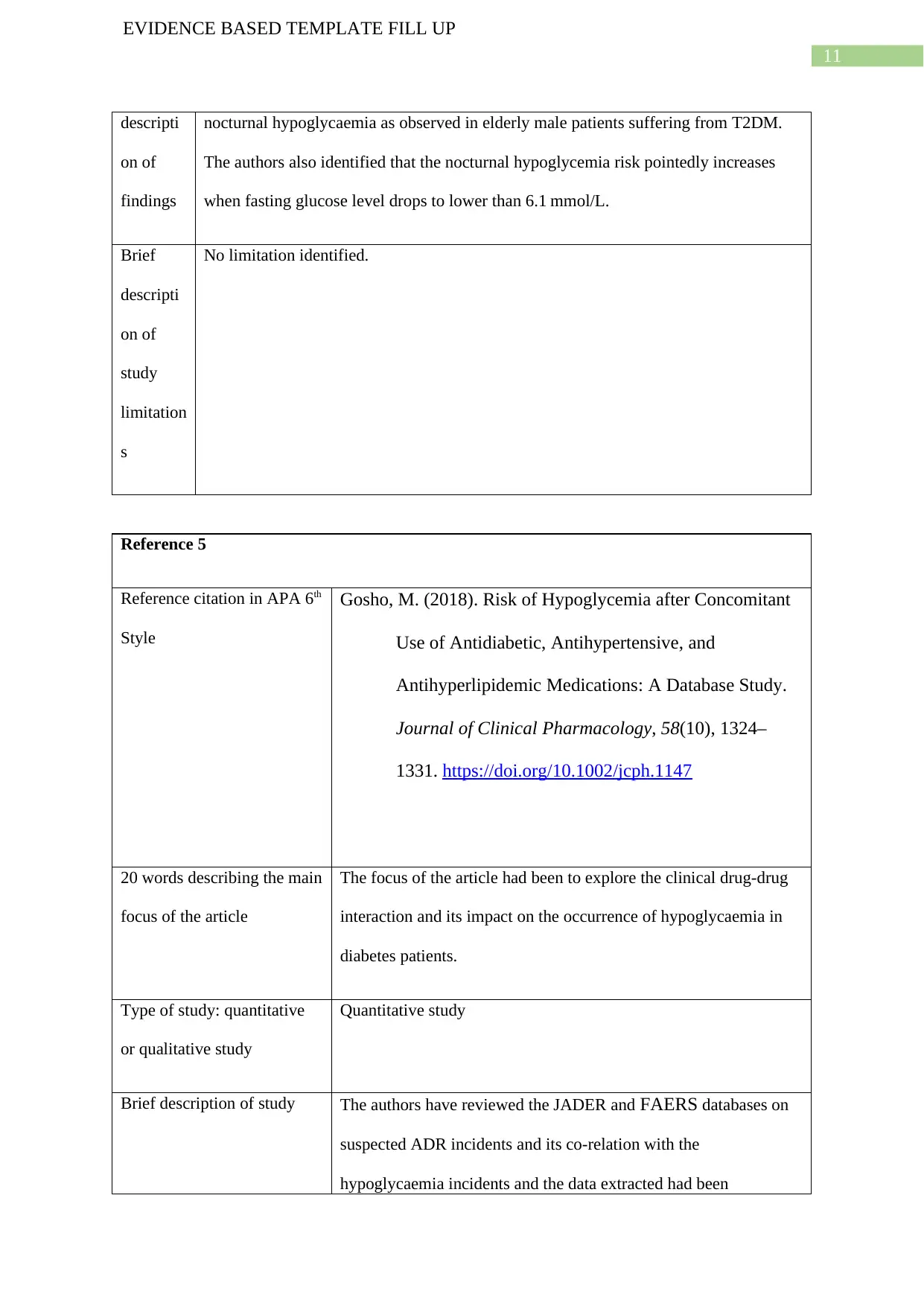
11
EVIDENCE BASED TEMPLATE FILL UP
descripti
on of
findings
nocturnal hypoglycaemia as observed in elderly male patients suffering from T2DM.
The authors also identified that the nocturnal hypoglycemia risk pointedly increases
when fasting glucose level drops to lower than 6.1 mmol/L.
Brief
descripti
on of
study
limitation
s
No limitation identified.
Reference 5
Reference citation in APA 6th
Style
Gosho, M. (2018). Risk of Hypoglycemia after Concomitant
Use of Antidiabetic, Antihypertensive, and
Antihyperlipidemic Medications: A Database Study.
Journal of Clinical Pharmacology, 58(10), 1324–
1331. https://doi.org/10.1002/jcph.1147
20 words describing the main
focus of the article
The focus of the article had been to explore the clinical drug-drug
interaction and its impact on the occurrence of hypoglycaemia in
diabetes patients.
Type of study: quantitative
or qualitative study
Quantitative study
Brief description of study The authors have reviewed the JADER and FAERS databases on
suspected ADR incidents and its co-relation with the
hypoglycaemia incidents and the data extracted had been
EVIDENCE BASED TEMPLATE FILL UP
descripti
on of
findings
nocturnal hypoglycaemia as observed in elderly male patients suffering from T2DM.
The authors also identified that the nocturnal hypoglycemia risk pointedly increases
when fasting glucose level drops to lower than 6.1 mmol/L.
Brief
descripti
on of
study
limitation
s
No limitation identified.
Reference 5
Reference citation in APA 6th
Style
Gosho, M. (2018). Risk of Hypoglycemia after Concomitant
Use of Antidiabetic, Antihypertensive, and
Antihyperlipidemic Medications: A Database Study.
Journal of Clinical Pharmacology, 58(10), 1324–
1331. https://doi.org/10.1002/jcph.1147
20 words describing the main
focus of the article
The focus of the article had been to explore the clinical drug-drug
interaction and its impact on the occurrence of hypoglycaemia in
diabetes patients.
Type of study: quantitative
or qualitative study
Quantitative study
Brief description of study The authors have reviewed the JADER and FAERS databases on
suspected ADR incidents and its co-relation with the
hypoglycaemia incidents and the data extracted had been
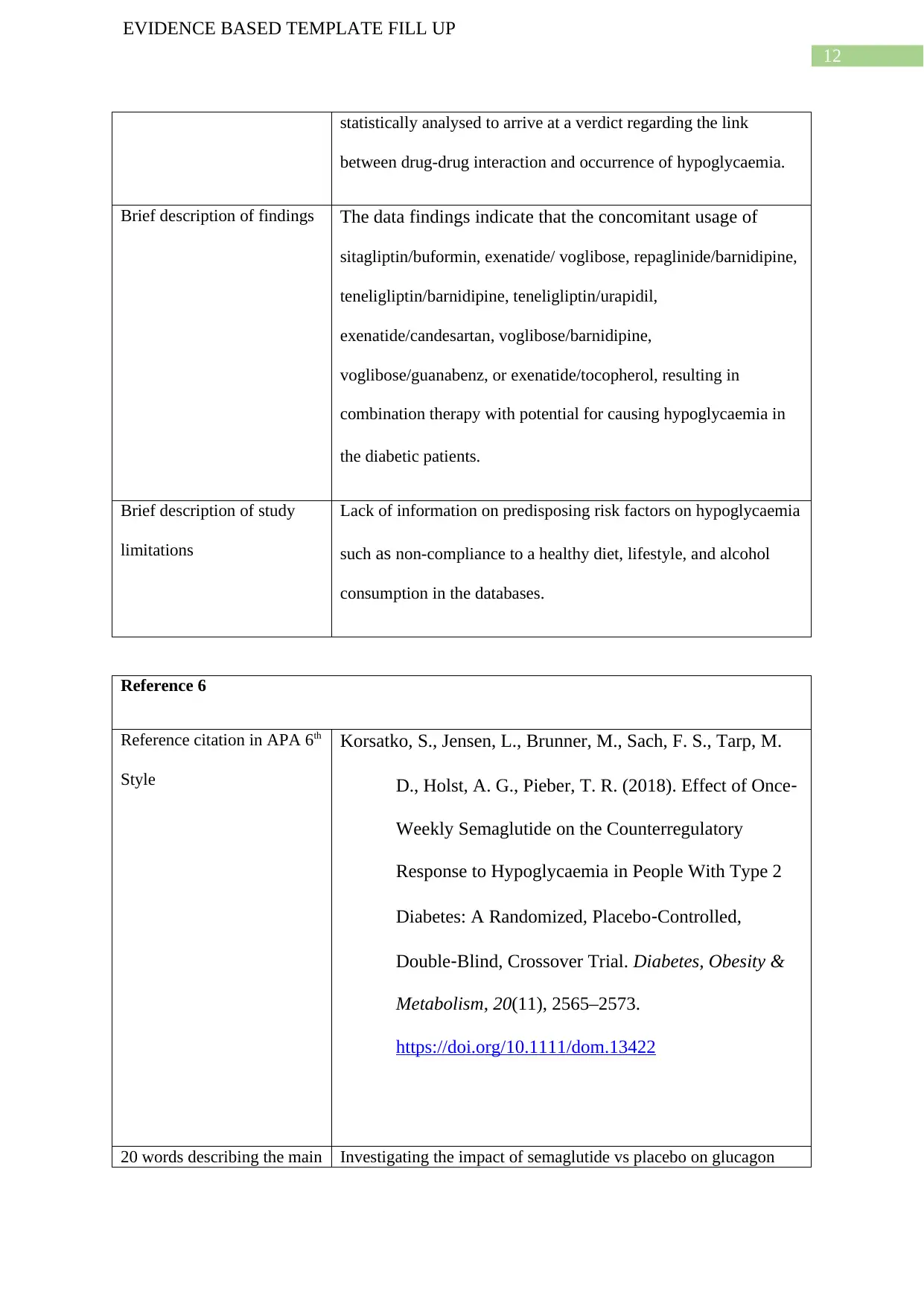
12
EVIDENCE BASED TEMPLATE FILL UP
statistically analysed to arrive at a verdict regarding the link
between drug-drug interaction and occurrence of hypoglycaemia.
Brief description of findings The data findings indicate that the concomitant usage of
sitagliptin/buformin, exenatide/ voglibose, repaglinide/barnidipine,
teneligliptin/barnidipine, teneligliptin/urapidil,
exenatide/candesartan, voglibose/barnidipine,
voglibose/guanabenz, or exenatide/tocopherol, resulting in
combination therapy with potential for causing hypoglycaemia in
the diabetic patients.
Brief description of study
limitations
Lack of information on predisposing risk factors on hypoglycaemia
such as non-compliance to a healthy diet, lifestyle, and alcohol
consumption in the databases.
Reference 6
Reference citation in APA 6th
Style
Korsatko, S., Jensen, L., Brunner, M., Sach, F. S., Tarp, M.
D., Holst, A. G., Pieber, T. R. (2018). Effect of Once‐
Weekly Semaglutide on the Counterregulatory
Response to Hypoglycaemia in People With Type 2
Diabetes: A Randomized, Placebo‐Controlled,
Double‐Blind, Crossover Trial. Diabetes, Obesity &
Metabolism, 20(11), 2565–2573.
https://doi.org/10.1111/dom.13422
20 words describing the main Investigating the impact of semaglutide vs placebo on glucagon
EVIDENCE BASED TEMPLATE FILL UP
statistically analysed to arrive at a verdict regarding the link
between drug-drug interaction and occurrence of hypoglycaemia.
Brief description of findings The data findings indicate that the concomitant usage of
sitagliptin/buformin, exenatide/ voglibose, repaglinide/barnidipine,
teneligliptin/barnidipine, teneligliptin/urapidil,
exenatide/candesartan, voglibose/barnidipine,
voglibose/guanabenz, or exenatide/tocopherol, resulting in
combination therapy with potential for causing hypoglycaemia in
the diabetic patients.
Brief description of study
limitations
Lack of information on predisposing risk factors on hypoglycaemia
such as non-compliance to a healthy diet, lifestyle, and alcohol
consumption in the databases.
Reference 6
Reference citation in APA 6th
Style
Korsatko, S., Jensen, L., Brunner, M., Sach, F. S., Tarp, M.
D., Holst, A. G., Pieber, T. R. (2018). Effect of Once‐
Weekly Semaglutide on the Counterregulatory
Response to Hypoglycaemia in People With Type 2
Diabetes: A Randomized, Placebo‐Controlled,
Double‐Blind, Crossover Trial. Diabetes, Obesity &
Metabolism, 20(11), 2565–2573.
https://doi.org/10.1111/dom.13422
20 words describing the main Investigating the impact of semaglutide vs placebo on glucagon
⊘ This is a preview!⊘
Do you want full access?
Subscribe today to unlock all pages.

Trusted by 1+ million students worldwide
1 out of 27
Related Documents
Your All-in-One AI-Powered Toolkit for Academic Success.
+13062052269
info@desklib.com
Available 24*7 on WhatsApp / Email
![[object Object]](/_next/static/media/star-bottom.7253800d.svg)
Unlock your academic potential
Copyright © 2020–2025 A2Z Services. All Rights Reserved. Developed and managed by ZUCOL.





